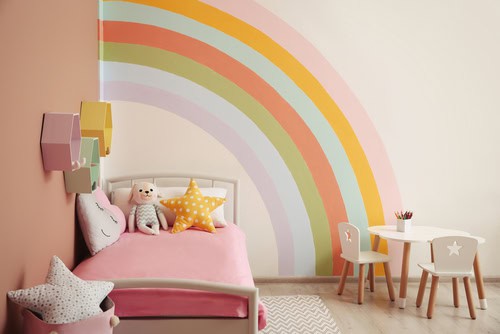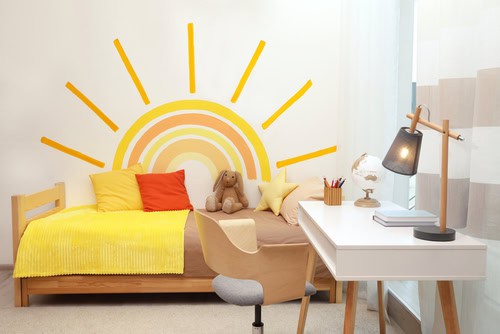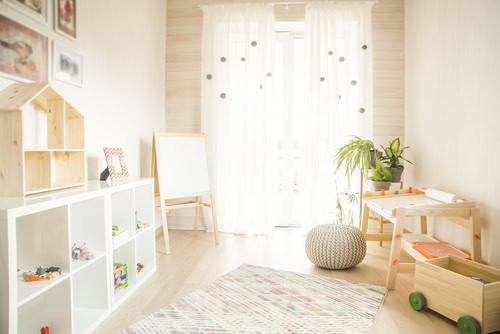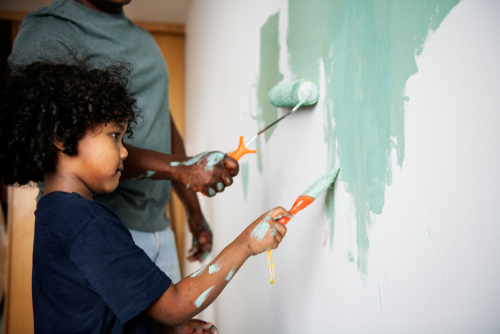
Setting Boundaries: Guidelines for Babysitters and Families
March 15, 2024Creative Ideas for Painting Children’s Rooms

Creative Ideas for Painting Children's Rooms

Creative Ideas for Painting Children’s Rooms. Transforming a child’s room through paint not only refreshes the space but also ignites their imagination and supports their well-being.
A child’s room is more than just a space for sleep; it’s a sanctuary for growth, play, and imagination.
The strategic use of paint can profoundly impact its function and feel, setting the stage for a childhood filled with creativity and joy.
From selecting the right hues to embracing innovative painting techniques, this guide offers a roadmap to designing enriching spaces that evolve alongside your child.
This comprehensive guide delves into various painting techniques and themes that promise to create an inspiring haven for your little ones.
Table of Contents
Planning for Flexibility and Growth
Children’s preferences and needs change rapidly, making flexibility a cornerstone of room design. Opting for adaptable themes and colors ensures the room remains relevant and cherished through various developmental stages.
Consider designs that cater to both current interests and future growth. For instance, a whimsical fairy tale theme can transition into a more mature fantasy landscape as the child grows, with minor adjustments in accessories and accent colors.
Nature, space exploration, and classic literature offer inexhaustible inspiration that can be tailored to any age. These themes encourage learning and curiosity, providing a backdrop that remains appealing over time.
Color Psychology in Children’s Rooms

The colors we choose can influence a child’s mood and energy levels. Understanding color psychology allows parents to craft spaces that support their child’s emotional health.
Bright yellows can inspire energy and happiness, making them perfect for play areas, while soft blues and greens may enhance concentration and calm, ideal for study or relaxation corners.
Consider your child’s temperament when selecting room colors. Active children might benefit from calming blues and greens, whereas more reserved children could be energized by warmer tones.
Engaging Themes and Patterns
Personal interests and hobbies can serve as direct inspiration for room themes, transforming ordinary spaces into worlds of adventure and discovery.
Popular Room Themes
Whether it’s a jungle safari, a superhero’s cityscape, or an underwater kingdom, thematic designs can be realized through creative painting techniques, including murals and decorative accents.
Creating Patterns
Geometric patterns or stripes add visual interest and can define different areas within the room. Tools like stencils and painters’ tape help achieve precise and playful patterns.
Interactive Paint Ideas

Incorporating interactive elements through paint not only decorates the room but also turns the walls into canvases for expression and learning.
Chalkboard Walls
Designate a section of the wall or an entire wall for chalkboard paint, offering a space for doodling, writing, or even practicing homework assignments.
Magnetic Paint
A wall painted with magnetic paint serves as a dynamic gallery for artwork or an educational tool for magnetic letters and numbers, aiding in interactive learning.
Educational and Inspirational Concepts
Incorporate educational elements subtly through decor, making learning a natural and enjoyable part of everyday life.
World Map Murals
A large, colorful mural of the world map encourages geographical curiosity and a global perspective, doubling as an engaging visual element.
Alphabet and Number Motifs
Integrate letters and numbers into the room’s design through borders, stenciled artwork, or even creative book displays, making foundational learning accessible and fun.
Creative Ceiling Treatments

Look up to the ceiling for additional space to inspire and captivate. Using the ceiling as a canvas can dramatically alter the room’s atmosphere.
Sky Themes
A ceiling painted with a day or night sky theme, complete with clouds, stars, or even a painted moon, invites daydreaming and can soothe bedtime anxieties.
Geometric Patterns
Bold, colorful patterns on the ceiling draw the eye upward, making the room feel larger and more dynamic. This technique can also delineate different zones within the room.
The Magic of Light and Color
Specialty paints can create surprising and delightful effects that change with the light or time of day.
Glow-in-the-Dark Paint
Stars, planets, or whimsical night creatures painted with glow-in-the-dark paint come alive at night, creating a mesmerizing bedtime environment.
Light-Reflective Paints
Use reflective paints to maximize natural light during the day, making the room feel brighter and more spacious, especially in smaller or north-facing rooms.
DIY Murals and Personalized Art
Creating personalized murals or art projects adds unique character to the room and makes memorable experiences for both parents and children.
Even without professional skills, simple mural designs can be achieved using projectors, stencils, or freehand sketches, inviting a personal touch to the space.
Incorporate your child’s own artwork or family handprints into the decor, celebrating creativity and adding a layer of sentimentality to the room.
Safety and Sustainability

Choosing the right materials ensures the room is not only beautiful but also safe and environmentally friendly.
Non-toxic, Low-VOC Paints
Prioritize the use of non-toxic, low-VOC paints to maintain indoor air quality, ensuring the room is safe for play, sleep, and growth.
Sustainable Practices
Select sustainable painting practices and materials, minimizing the environmental footprint of your decorating project while safeguarding your child’s health.
FAQs
How Do I Choose Between Matte, Satin, and Glossy Finishes?
Evaluate the room’s activity level and lighting. Matte is great for hiding imperfections, satin offers a balance of usability and washability, and glossy finishes are durable and easy to clean, ideal for high-traffic areas or places prone to messes.
Can Modern Painting Techniques Be Applied Over Wallpaper?
Yes, but ensure the wallpaper is securely adhered to the wall and consider priming over it for a smooth base. Removing wallpaper provides the best surface for new paint applications.
What Is the Best Way to Practice a New Painting Technique?
Experiment on sample boards or small sections of the wall not immediately visible. This allows you to refine the technique and adjust colors before committing to the entire room.
Are There Eco-Friendly Paint Options for Modern Painting Techniques?
Absolutely. Look for paints labeled as low-VOC or no-VOC, which are better for the environment and safer for indoor air quality, especially in children’s rooms.
How Often Should Themes or Colors Be Updated in a Child’s Room?
This depends on the child’s changing interests and the room’s design flexibility.
Some themes can grow with the child, while others may need updating every few years to match their current age and preferences. Involving your child in these decisions can make transitions more meaningful.
Creative Ideas for Painting Children’s Rooms – Conclusion

A child’s room is a canvas for imagination, learning, and growth. Through creative painting techniques and thoughtful design, parents can create spaces that inspire wonder, comfort, and joy.
Engaging with your child in the design process not only personalizes the space but also makes the transformation a memorable journey of creativity and expression!
Are you seeking a professional and reliable babysitting service in Singapore? Contact us today!

